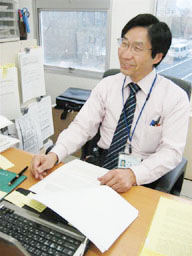Hiroshima Memo: An Inconvenient Truth
Jan. 24, 2008
by Akira Tashiro, Executive Director of the Hiroshima Peace Media Center
The other day I interviewed an old friend, Martin Sherwin, by telephone and he told me, “Nuclear weapons are the most inconvenient truth.” Of course, “An Inconvenient Truth” is the title of Al Gore’s acclaimed documentary about global warming, a film that has attracted considerable attention in Japan, too.
Melting glaciers, mounting hurricanes... The film depicts a range of changes now occurring in nature due to global warming and appeals for a transformation in the way human beings live in order to save our environment from catastrophe. In fact, the environmental issue has become an important theme of the presidential race in the United States.
But like global warming, why isn’t the “inconvenient truth” of nuclear weapons a higher-profile concern?
If a nuclear weapon is used, it will bring about devastation beyond human imagination. Even a “dirty bomb” detonated in a densely-populated area, the result of plutonium or another hazardous material falling into the hands of terrorists, can create a colossal disaster.
In 2000-2001, I visited a number of major nuclear weapons-related facilities in the United States and the former Soviet Union and wrote a series of articles that revealed the reality of nuclear contamination and human suffering caused by radioactive waste and other factors. By investigating these areas in person, and hearing the stories of workers and residents firsthand, this “inconvenient truth” is readily understood. However, the mainstream media in the United States and Russia rarely report on the issue of nuclear contamination. As a consequence, most people in these countries are not clearly aware of the serious environmental pollution occurring around them.
The atomic bombings of Hiroshima and Nagasaki are the archetypes of this “inconvenient truth” of nuclear weapons. To raise awareness among the American people, the city of Hiroshima is now holding atomic bomb exhibitions in the United States, in 101 cities, to convey the reality of nuclear weapons in the hopes that the nuclear peril can become an important campaign issue during this year’s presidential election.
Like small circles rippling outward on a pond, I’m optimistic these exhibitions will have a broadening impact on the American public. With this fervent hope, the city of ground zero, Hiroshima, will continue its efforts to advance peace.
The other day I interviewed an old friend, Martin Sherwin, by telephone and he told me, “Nuclear weapons are the most inconvenient truth.” Of course, “An Inconvenient Truth” is the title of Al Gore’s acclaimed documentary about global warming, a film that has attracted considerable attention in Japan, too.
Melting glaciers, mounting hurricanes... The film depicts a range of changes now occurring in nature due to global warming and appeals for a transformation in the way human beings live in order to save our environment from catastrophe. In fact, the environmental issue has become an important theme of the presidential race in the United States.
But like global warming, why isn’t the “inconvenient truth” of nuclear weapons a higher-profile concern?
If a nuclear weapon is used, it will bring about devastation beyond human imagination. Even a “dirty bomb” detonated in a densely-populated area, the result of plutonium or another hazardous material falling into the hands of terrorists, can create a colossal disaster.
In 2000-2001, I visited a number of major nuclear weapons-related facilities in the United States and the former Soviet Union and wrote a series of articles that revealed the reality of nuclear contamination and human suffering caused by radioactive waste and other factors. By investigating these areas in person, and hearing the stories of workers and residents firsthand, this “inconvenient truth” is readily understood. However, the mainstream media in the United States and Russia rarely report on the issue of nuclear contamination. As a consequence, most people in these countries are not clearly aware of the serious environmental pollution occurring around them.
The atomic bombings of Hiroshima and Nagasaki are the archetypes of this “inconvenient truth” of nuclear weapons. To raise awareness among the American people, the city of Hiroshima is now holding atomic bomb exhibitions in the United States, in 101 cities, to convey the reality of nuclear weapons in the hopes that the nuclear peril can become an important campaign issue during this year’s presidential election.
Like small circles rippling outward on a pond, I’m optimistic these exhibitions will have a broadening impact on the American public. With this fervent hope, the city of ground zero, Hiroshima, will continue its efforts to advance peace.








